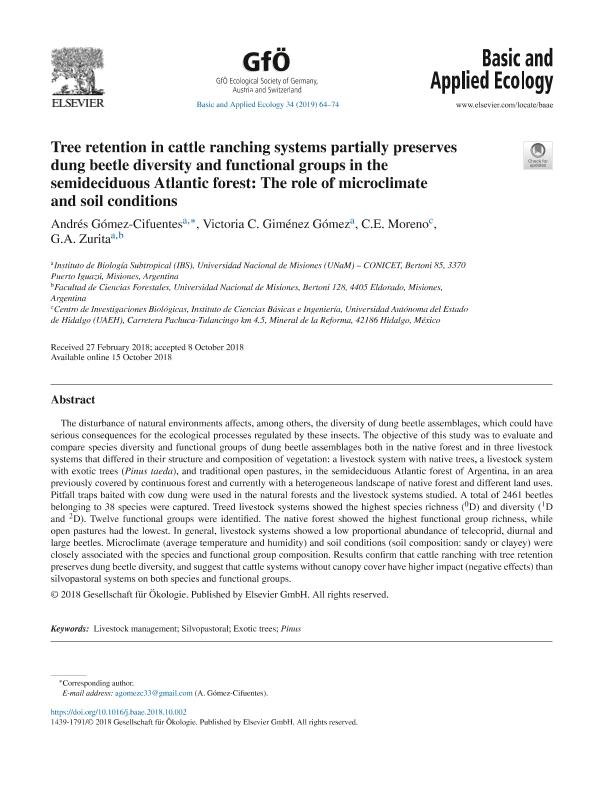Mostrar el registro sencillo del ítem
dc.contributor.author
Gomez Cifuentes, Andres Mauricio

dc.contributor.author
Gimenez Gomez, Victoria Carolina

dc.contributor.author
Moreno, Claudia E.
dc.contributor.author
Zurita, Gustavo Andres

dc.date.available
2020-07-17T20:20:49Z
dc.date.issued
2018-10
dc.identifier.citation
Gomez Cifuentes, Andres Mauricio; Gimenez Gomez, Victoria Carolina; Moreno, Claudia E.; Zurita, Gustavo Andres; Tree retention in cattle ranching systems partially preserves dung beetle diversity and functional groups in the semideciduous Atlantic forest: The role of microclimate and soil conditions; Elsevier Gmbh, Urban & Fischer Verlag; Basic and Applied Ecology; 34; 10-2018; 64-74
dc.identifier.issn
1439-1791
dc.identifier.uri
http://hdl.handle.net/11336/109594
dc.description.abstract
The disturbance of natural environments affects, among others, the diversity of dung beetle assemblages, which could have serious consequences for the ecological processes regulated by these insects. The objective of this study was to evaluate and compare species diversity and functional groups of dung beetle assemblages both in the native forest and in three livestock systems that differed in their structure and composition of vegetation: a livestock system with native trees, a livestock system with exotic trees (Pinus taeda), and traditional open pastures, in the semideciduous Atlantic forest of Argentina, in an area previously covered by continuous forest and currently with a heterogeneous landscape of native forest and different land uses. Pitfall traps baited with cow dung were used in the natural forests and the livestock systems studied. A total of 2461 beetles belonging to 38 species were captured. Treed livestock systems showed the highest species richness ( 0 D) and diversity ( 1 D and 2 D). Twelve functional groups were identified. The native forest showed the highest functional group richness, while open pastures had the lowest. In general, livestock systems showed a low proportional abundance of telecoprid, diurnal and large beetles. Microclimate (average temperature and humidity) and soil conditions (soil composition: sandy or clayey) were closely associated with the species and functional group composition. Results confirm that cattle ranching with tree retention preserves dung beetle diversity, and suggest that cattle systems without canopy cover have higher impact (negative effects) than silvopastoral systems on both species and functional groups.
dc.format
application/pdf
dc.language.iso
eng
dc.publisher
Elsevier Gmbh, Urban & Fischer Verlag

dc.rights
info:eu-repo/semantics/openAccess
dc.rights.uri
https://creativecommons.org/licenses/by-nc-nd/2.5/ar/
dc.subject
EXOTIC TREES
dc.subject
LIVESTOCK MANAGEMENT
dc.subject
PINUS
dc.subject
SILVOPASTORAL
dc.subject.classification
Ecología

dc.subject.classification
Ciencias Biológicas

dc.subject.classification
CIENCIAS NATURALES Y EXACTAS

dc.subject.classification
Conservación de la Biodiversidad

dc.subject.classification
Ciencias Biológicas

dc.subject.classification
CIENCIAS NATURALES Y EXACTAS

dc.title
Tree retention in cattle ranching systems partially preserves dung beetle diversity and functional groups in the semideciduous Atlantic forest: The role of microclimate and soil conditions
dc.type
info:eu-repo/semantics/article
dc.type
info:ar-repo/semantics/artículo
dc.type
info:eu-repo/semantics/publishedVersion
dc.date.updated
2020-06-30T13:52:02Z
dc.identifier.eissn
1439-1791
dc.journal.volume
34
dc.journal.pagination
64-74
dc.journal.pais
Alemania

dc.description.fil
Fil: Gomez Cifuentes, Andres Mauricio. Consejo Nacional de Investigaciones Científicas y Técnicas. Centro Científico Tecnológico Conicet - Nordeste. Instituto de Biología Subtropical. Instituto de Biología Subtropical - Nodo Puerto Iguazú | Universidad Nacional de Misiones. Instituto de Biología Subtropical. Instituto de Biología Subtropical - Nodo Puerto Iguazú; Argentina
dc.description.fil
Fil: Gimenez Gomez, Victoria Carolina. Consejo Nacional de Investigaciones Científicas y Técnicas. Centro Científico Tecnológico Conicet - Nordeste. Instituto de Biología Subtropical. Instituto de Biología Subtropical - Nodo Puerto Iguazú | Universidad Nacional de Misiones. Instituto de Biología Subtropical. Instituto de Biología Subtropical - Nodo Puerto Iguazú; Argentina
dc.description.fil
Fil: Moreno, Claudia E.. Universidad Autónoma del Estado de Hidalgo; México
dc.description.fil
Fil: Zurita, Gustavo Andres. Universidad Nacional de Misiones; Argentina. Consejo Nacional de Investigaciones Científicas y Técnicas. Centro Científico Tecnológico Conicet - Nordeste. Instituto de Biología Subtropical. Instituto de Biología Subtropical - Nodo Puerto Iguazú | Universidad Nacional de Misiones. Instituto de Biología Subtropical. Instituto de Biología Subtropical - Nodo Puerto Iguazú; Argentina
dc.journal.title
Basic and Applied Ecology

dc.relation.alternativeid
info:eu-repo/semantics/altIdentifier/doi/http://dx.doi.org/10.1016/j.baae.2018.10.002
dc.relation.alternativeid
info:eu-repo/semantics/altIdentifier/url/https://www.sciencedirect.com/science/article/abs/pii/S1439179118300549
Archivos asociados
